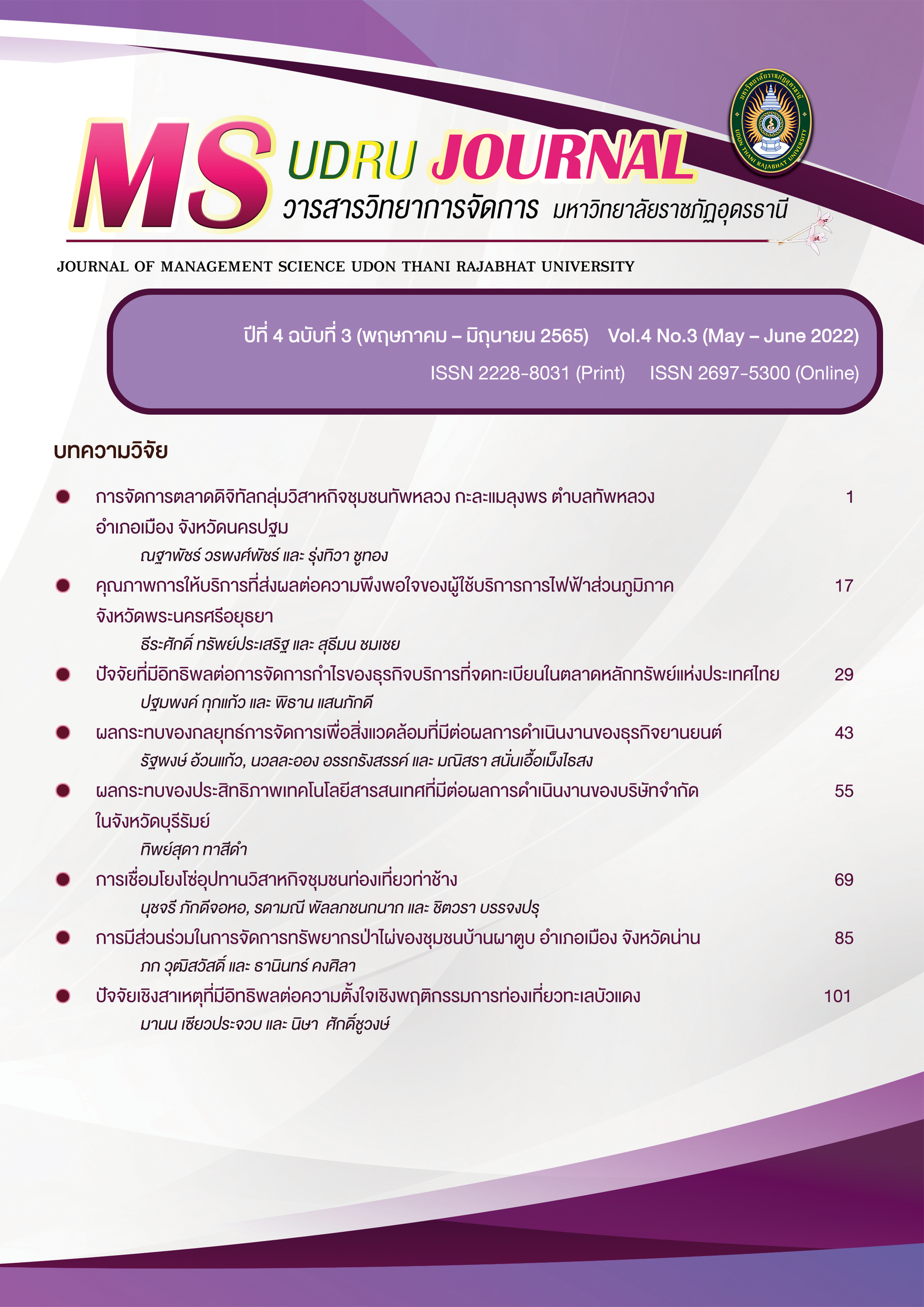PARTICIPATORY MANAGEMENT IN BAMBOO RESOURCES AT BAN PHATUM AMPHUR MUANG, NAN PROVINCE
Main Article Content
Abstract
The purposes of this research were to 1) study the context of Ban Phatub Amphur Muang Nan in each dimension and 2) analyze the factors influencing on participatory management in bamboo resources. This research was determined with 143 questionnaires (1 person per household) which were representatives for the overall households at Ban Phatub and 80 villagers who dwell surrounding the national park of Ban Phatub. The in-depth interview method was designed for 13 key informants and the focus group.
The result found that the context of situation on the plentiful in the geographical and physical were demonstrated of Ban Phatub in community moreover the other factors play the important role on local development as leader, member group. In term of participation, the percentage of the opinion decision making was 100.00 % for the operation in the bamboo resources management. The existence of resources were the mechanism for activities in conservation, protection and restoration. Therefore, the scheme was determined along with the context of community according to the guideline for rural development.
Article Details

This work is licensed under a Creative Commons Attribution-NonCommercial-NoDerivatives 4.0 International License.
บทความที่ได้รับการตีพิมพ์เป็นลิขสิทธิ์ของคณะวิทยาการจัดการ มหาวิทยาลัยราชภัฏอุดรธานี
ข้อความที่ปรากฏในบทความแต่ละเรื่องในวารสารวิชาการเล่มนี้ ไม่ใช่ความคิดเห็นและความรับผิดชอบของผู้จัดทำ บรรณาธิการ กองบรรณาธิการ และคณะวิทยาการจัดการ มหาวิทยาลัยราชภัฏอุดรธานี ความรับผิดชอบด้านเนื้อหาและการตรวจร่างบทความแต่ละเรื่องเป็นความคิดเห็นของผู้เขียนบทความแต่ละท่าน
References
แผนพัฒนาเศรษฐกิจและสังคมแห่งชาติฉบับที่ 8. (2539). การมีส่วนร่วมการจัดการทรัพยากร ธรรมชาติของท้องถิ่น. กรุงเทพฯ: สำนักนายกรัฐมนตรี รัฐสภา.
ไพฑูรย์ อินต๊ะขัน, ณัฐนันท์ ฐิติยาปราโมทย์, สุขเกษม ลางคุลเสน, นันทะ บุตรน้อย, กนกพร ศรีวิชัย และฐิฏิกานต์ สุยะสาร. (2563). การพัฒนาการดำเนินงานวิสาหกิจชุมชนกลุ่มตัดเย็บสู่ความเข้มแข็งอย่างเป็นระบบ อำเภอแม่เมาะ จังหวัดลำปาง. วารสารวิทยาการจัดการ มหาวิทยาลัยราชภัฏอุดรธานี, 2(4). 63-75.
วรานันต์ ตันตเวทย์. (2554). การประเมินมูลค่าโลมาสีชมพูทางเศรษฐศาสตร์และการปรับตัวของกิจกรรมการท่องเที่ยว: กรณีศึกษา อำเภอขนอม จังหวัดนครศรีธรรมราช. วิทยานิพนธ์มหาบัณฑิต คณะเศรษฐศาสตร์ มหาวิทยาลัยเกษตรศาสตร์.
วิโรจน์ เจษฎาลักษณ์ และธัญญา รัตน์สอนสุภาพ. (2563). การจัดการตามแนวคิดเศรษฐกิจหมุนเวียนตลาดอมยิ้ม.วารสารวิทยากรจัดการ มหาวิทยาลัยราชภัฏอุดรธานี, 2(6). 33-44.
ศรีประไพ คุ้มศรัตรา. (2559). ศึกษาการมีส่วนร่วมของประชาชนในการอนุรักษ์ป่าชุมชน: ศึกษากรณีตำบลช่องสะเดา อำเภอเมืองกาญจนบุรี. วารสารมนุษยศาสตร์และสังคมศาสตร์ มหาวิทยาลัยราชพฤกษ์, 1(3). 59-68.
ศศิน เฉลิมลาภ. (2557). ความหลากหลายทางชีวภาพสู่แนวทางการจัดการทรัพยากรธรรมชาติใน ประเทศไทย . กรุงเทพฯ: มูลนิธิสืบนาคะเสถียร.
สัจจา บรรจงศิริ. (2561). แนวทางการบริหารจัดการทรัพยากรน้ำแบบมีส่วนร่วมของภาคประชาชน: กรณีศึกษาพื้นที่ลุ่มน้ำน่าน. นนทบุรี: มหาวิทยาลัยสุโขทัยธรรมาธิราช.
สำนักงานวนอุทยานถ้ำผาตูบ. (2562). ข้อมูลวนอุทยานถ้ำผาตูบ จังหวัดน่าน. กรุงเทพฯ: กระทรวงทรัพยากรธรรมชาติและสิ่งแวดล้อม.
สำนักปลัดองค์การบริหารส่วนตำบลผาสิงห์. (2562). ข้อมูลตำบลผาสิงห์. น่าน: องค์การบริหารส่วนตำบลผาสิงห์.
หทัยชนก วงค์บุญชา. (2563). การวิเคราะห์องค์ประกอบเชิงยืนยันอันดับสองปัจจัยที่ส่งผลต่อความพอใจการจัดการเรียนรู้ในหลักสูตรของคณะวิทยาการจัดการ มหาวิทยาลัยราชภัฏอุดรธานี. วารสารวิทยาการจัดการ.มหาวิทยาลัยราชภัฏอุดรธานี, 2(6). 105-117.
Cohen, J.M., & Uphoff, N.T. (1980). Seeking clarity through specificity. New York: World Developments.
Likert, R. A. (1932). Technique for the Measurement of Attitude. Archives Psychological, 3(1), 42-48.
Ostrom, E. (1997). Governing the Commons: The Evolution of Institutions for Collective Action. United Kingdom: Cambridge University.
Randy, S. (2013). The Community Development Context of Research. London: Sage Publications,.


